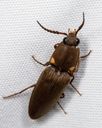Pyrophorini
Pyrophorini
Classification
- Phylum: Arthropoda
- Subphylum: Hexapoda
- Class: Insecta
- Order: Coleoptera
- Suborder: Polyphaga
- Superfamily: Elateroidea
- Family: Elateridae
- Subfamily: Agrypninae
- Tribe: Pyrophorini
Pronunciation
How to pronounce Pyrophorini: //ˌpaɪɹoʊˈfɔɹɪnaɪ//
These audio files are automatically generated. While they are not always 100% accurate, they are a good starting point.
Images






Summary
The Pyrophorini are a distinct tribe of bioluminescent beetles within the Elateridae family, primarily found in the New World, particularly known for their unique reproductive behaviors and ecological roles as decomposers and potential pollinators.
Physical Characteristics
Bioluminescent beetles; generally exhibit illumination in certain body parts, particularly in the abdominal area.
Identification Tips
Look for bioluminescent traits and characteristic morphological features such as elongated body shapes typical of click beetles.
Habitat
Typically found in forested areas, often in leaf litter or near decaying wood.
Distribution
Found in the New World, specifically in southern regions such as Florida and Arizona.
Diet
Larvae may feed on decaying organic matter; adults are thought to feed on nectar or pollen but specific diets vary by species.
Life Cycle
The life cycle includes egg, larval, pupal, and adult stages; bioluminescence is mainly observed in the adult stage.
Reproduction
Mating behaviors often involve bioluminescent displays; specific reproductive strategies may vary among species.
Predators
Birds, amphibians, and other predatory insects may prey on Pyrophorini beetles.
Ecosystem Role
Serve as decomposers and may play a role in pollination; bioluminescence may have ecological functions related to predation and mating.
Collecting Methods
- Light traps during nighttime as adults are bioluminescent and attracted to light.
- Netting from foliage and leaf litter.
Preservation Methods
- Drying specimens in a cool, dark environment to preserve bioluminescent properties.
- Using ethanol or freezing for preservation if immediate preparation is not possible.
Evolution
Believed to be monophyletic, the tribe has a close evolutionary relationship with other bioluminescent beetles.
Similar Taxa
- Anaissini (closely related tribe)
- Campyloxeninae (a different monotypic subfamily with bioluminescent species)
- Sinopyrophoridae (newly recognized bioluminescent beetle family)
Misconceptions
Some may confuse Pyrophorini with other bioluminescent beetles from different families or tribes due to their similar appearances.
Tags
- bioluminescent
- beetles
- Pyrophorini
- Elateridae
- Agrypninae